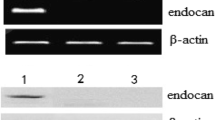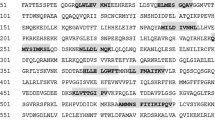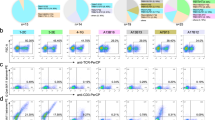Abstract
Ran is considered to be a promising target for tumor-specific immunotherapy because its protein is exclusively expressed in tumor tissues, though its mRNA can be expressed in most normal tissues. In our study, we obtained four candidate wild-type epitopes designated Ran1, Ran2, Ran3, and Ran4, derived from the Ran antigen with the highest predicted affinity with MHC-I, indicated by affinity prediction plots and molecular dynamics simulation. However, in vitro affinity assays of these epitopes showed only a moderate affinity with MHC-I. Thus, we designed altered peptide ligands (APLs) derived from Ran wild-type epitopes with preferred primary and auxiliary HLA-A*0201 molecule anchor residue replacement. Of the eight tested peptides, the 1Y analog had the strongest binding-affinity and lowest-dissociation rate to HLA-A*0201. Additionally, we investigated the CTLs activities induced by Ran wild-type peptides and the APLs in human PBMCs and in HLA-A*0201/Kb transgenic mice. Ran1 1Y was superior to other APLs and wild-type peptides in eliciting epitope-specific CTL immune responses both in vitro and in vivo. In summary, a wild-type epitope of the tumor-specific antigen Ran, expressed broadly in many tumors, was identified and designated Ran1. An APL of Ran1, Ran1 1Y, was further designed and verified in vitro and in vivo and found to elicit a stronger Ran-specific CTL response, indicating a potential anti-tumor application in the future.






Similar content being viewed by others
References
Rosenberg SA (1999) A new era for cancer immunotherapy based on the genes that encode cancer antigens. Immunity 10:281–287
Rosenberg SA (2001) Progress in human tumour immunology and immunotherapy. Nature 411:380–384
Ribas A, Butterfield LH, Glaspy JA, Economou JS (2003) Current developments in cancer vaccines and cellular immunotherapy. J Clin Oncol 21:2415–2432
Finn OJ (2003) Cancer vaccines: between the idea and the reality. Nat Rev Immunol 3:630–641
Mine T, Gouhara R, Hida N, Imai N, Azuma K, Rikimaru T, Katagiri K, Nishikori M, Sukehiro A, Nakagawa M, Yamada A, Aizawa H, Shirouzu K, Itoh K, Yamana H (2003) Immunological evaluation of CTL precursor-oriented vaccines for advanced lung cancer patients. Cancer Sci 94:548–556
Novellino L, Castelli C, Parmiani G (2005) A listing of human tumor antigens recognized by T cells: March 2004 update. Cancer Immunol Immunother 54:187–207
Weis K (2003) Regulating access to the genome: nucleocytoplasmic transport throughout the cell cycle. Cell 112:441–451
Kunzler M, Hurt E (2001) Targeting of Ran: variation on a common theme? J Cell Sci 114:3233–3241
Kierszenbaum AL, Gil M, Rivkin E, Tres LL (2002) Ran, a GTP-binding protein involved in nucleocytoplasmic transport and microtubule nucleation, relocates from the manchette to the centrosome region during rat spermiogenesis. Mol Reprod Dev 63:131–140
Li HY, Zheng Y (2004) Phosphorylation of RCC1 in mitosis is essential for producing a high RanGTP concentration on chromosomes and for spindle assembly in mammalian cells. Genes Dev 18:512–527
Zhang C, Clarke PR (2000) Chromatin-independent nuclear envelope assembly induced by Ran GTPase in Xenopus egg extracts. Science 288:1429–1432
Hetzer M, Bilbao-Cortes D, Walther TC, Gruss OJ, Mattaj IW (2000) GTP hydrolysis by Ran is required for nuclear envelope assembly. Mol Cell 5:1013–1024
Vasu SK, Forbes DJ (2001) Nuclear pores and nuclear assembly. Curr Opin Cell Biol 13:363–375
Kornbluth S, Dasso M, Newport J (1994) Evidence for a dual role for TC4 protein in regulating nuclear structure and cell cycle progression. J Cell Biol 125:705–719
Azuma K, Sasada T, Takedatsu H, Shomura H, Koga M, Maeda Y, Yao A, Hirai T, Takabayashi A, Shichijo S, Itoh K (2004) Ran, a small GTPase gene, encodes cytotoxic T lymphocyte (CTL) epitopes capable of inducing HLA-A33-restricted and tumor-reactive CTLs in cancer patients. Clin Cancer Res 10:6695–6702
Shieh DC, Lin DT, Yang BS, Kuan HL, Kao KJ (1996) High frequency of HLA-A*0207 subtype in Chinese population. Transfusion 36:818–821
Valmori D, Fonteneau JF, Lizana CM, Gervois N, Lienard D, Rimoldi D, Jongeneel V, Jotereau F, Cerottini JC, Romero P (1998) Enhanced generation of specific tumor-reactive CTL in vitro by selected Melan-A/MART-1 immunodominant peptide analogues. J Immunol 160:1750–1758
Parkhurst MR, Salgaller ML, Southwood S, Robbins PF, Sette A, Rosenberg SA, Kawakami Y (1996) Improved induction of melanoma-reactive CTL with peptides from the melanoma antigen gp100 modified at HLA-A*0201-binding residues. J Immunol 157:2539–2548
Ruppert J, Sidney J, Celis E, Kubo RT, Grey HM, Sette A (1993) Prominent role of secondary anchor residues in peptide binding to HLA-A2.1 molecules. Cell 74:929–937
Tourdot S, Scardino A, Saloustrou E, Gross DA, Pascolo S, Cordopatis P, Lemonnier FA, Kosmatopoulos K (2000) A general strategy to enhance immunogenicity of low-affinity HLA-A2.1-associated peptides: implication in the identification of cryptic tumor epitopes. Eur J Immunol 30:3411–3421
Nijman HW, Houbiers JG, Vierboom MP, van der Burg SH, Drijfhout JW, D’Amaro J, Kenemans P, Melief CJ, Kast WM (1993) Identification of peptide sequences that potentially trigger HLA-A2.1-restricted cytotoxic T lymphocytes. Eur J Immunol 23:1215–1219
Parker KC, Bednarek MA, Coligan JE (1994) Scheme for ranking potential HLA-A2 binding peptides based on independent binding of individual peptide side-chains. J Immunol 152:163–175
Rammensee H, Bachmann J, Emmerich NP, Bachor OA, Stevanovic S (1999) SYFPEITHI: database for MHC ligands and peptide motifs. Immunogenetics 50:213–219
Yang S, Linette GP, Longerich S, Haluska FG (2002) Antimelanoma activity of CTL generated from peripheral blood mononuclear cells after stimulation with autologous dendritic cells pulsed with melanoma gp100 peptide G209-2M is correlated to TCR avidity. J Immunol 169:531–539
Mellman I, Steinman RM (2001) Dendritic cells: specialized and regulated antigen processing machines. Cell 106:255–258
Tang Y, Lin Z, Ni B, Wei J, Han J, Wang H, Wu Y (2007) An altered peptide ligand for naive cytotoxic T lymphocyte epitope of TRP-2(180–188) enhanced immunogenicity. Cancer Immunol Immunother 56:319–329
Zhu B, Chen Z, Cheng X, Lin Z, Guo J, Jia Z, Zou L, Wang Z, Hu Y, Wang D, Wu Y (2003) Identification of HLA-A*0201-restricted cytotoxic T lymphocyte epitope from TRAG-3 antigen. Clin Cancer Res 9:1850–1857
Ni B, Gao W, Zhu B, Lin Z, Jia Z, Zhou W, Zhao J, Wang L, Wu Y (2005) Induction of specific human primary immune responses to a Semliki Forest virus-based tumor vaccine in a Trimera mouse model. Cancer Immunol Immunother 54:489–498
Ida K, Kawaguchi S, Sato Y, Tsukahara T, Nabeta Y, Sahara H, Ikeda H, Torigoe T, Ichimiya S, Kamiguchi K, Wada T, Nagoya S, Hiraga H, Kawai A, Ishii T, Araki N, Myoui A, Matsumoto S, Ozaki T, Yoshikawa H, Yamashita T, Sato N (2004) Crisscross CTL induction by SYT-SSX junction peptide and its HLA-A*2402 anchor substitute. J Immunol 173:1436–1443
Slansky JE, Rattis FM, Boyd LF, Fahmy T, Jaffee EM, Schneck JP, Margulies DH, Pardoll DM (2000) Enhanced antigen-specific antitumor immunity with altered peptide ligands that stabilize the MHC-peptide-TCR complex. Immunity 13:529–538
Yu Z, Theoret MR, Touloukian CE, Surman DR, Garman SC, Feigenbaum L, Baxter TK, Baker BM, Restifo NP (2004) Poor immunogenicity of a self/tumor antigen derives from peptide–MHC-I instability and is independent of tolerance. J Clin Invest 114:551–559
Han JF, Zhao TT, Liu HL, Lin ZH, Wang HM, Ruan ZH, Zou LY, Wu YZ (2006) Identification of a new HLA-A*0201-restricted cytotoxic T lymphocyte epitope from CML28. Cancer Immunol Immunother 55:1575–1583
Celis E, Fikes J, Wentworth P, Sidney J, Southwood S, Maewal A, Del Guercio MF, Sette A, Livingston B (1994) Identification of potential CTL epitopes of tumor-associated antigen MAGE-1 for five common HLA-A alleles. Mol Immunol 31:1423–1430
van der Bruggen P, Bastin J, Gajewski T, Coulie PG, Boel P, De Smet C, Traversari C, Townsend A, Boon T (1994) A peptide encoded by human gene MAGE-3 and presented by HLA-A2 induces cytolytic T lymphocytes that recognize tumor cells expressing MAGE-3. Eur J Immunol 24:3038–3043
Parkhurst MR, Fitzgerald EB, Southwood S, Sette A, Rosenberg SA, Kawakami Y (1998) Identification of a shared HLA-A*0201-restricted T-cell epitope from the melanoma antigen tyrosinase-related protein 2 (TRP2). Cancer Res 58:4895–4901
Xia F, Lee CW, Altieri DC (2008) Tumor cell dependence on Ran-GTP-directed mitosis. Cancer Res 68:1826–1833
Li P, Yu X, Ge K, Melamed J, Roeder RG, Wang Z (2002) Heterogeneous expression and functions of androgen receptor co-factors in primary prostate cancer. Am J Pathol 161:1467–1474
Li SR, Gyselman VG, Dorudi S, Bustin SA (2000) Elevated levels of RanBP7 mRNA in colorectal carcinoma are associated with increased proliferation and are similar to the transcription pattern of the proto-oncogene c-myc. Biochem Biophys Res Commun 271:537–543
Emberley ED, Gietz RD, Campbell JD, HayGlass KT, Murphy LC, Watson PH (2002) RanBPM interacts with psoriasin in vitro and their expression correlates with specific clinical features in vivo in breast cancer. BMC Cancer 2:28
Abe H, Kamai T, Shirataki H, Oyama T, Arai K, Yoshida K (2008) High expression of Ran GTPase is associated with local invasion and metastasis of human clear cell renal cell carcinoma. Int J Cancer 122:2391–2397
Loftus DJ, Squarcina P, Nielsen MB, Geisler C, Castelli C, Odum N, Appella E, Parmiani G, Rivoltini L (1998) Peptides derived from self-proteins as partial agonists and antagonists of human CD8+ T-cell clones reactive to melanoma/melanocyte epitope MART1(27–35). Cancer Res 58:2433–2439
Rosenberg SA, Yang JC, Schwartzentruber DJ, Hwu P, Marincola FM, Topalian SL, Restifo NP, Dudley ME, Schwarz SL, Spiess PJ, Wunderlich JR, Parkhurst MR, Kawakami Y, Seipp CA, Einhorn JH, White DE (1998) Immunologic and therapeutic evaluation of a synthetic peptide vaccine for the treatment of patients with metastatic melanoma. Nat Med 4:321–327
Huppa JB, Gleimer M, Sumen C, Davis MM (2003) Continuous T cell receptor signaling required for synapse maintenance and full effector potential. Nat Immunol 4:749–755
Shen L, Rock KL (2004) Cellular protein is the source of cross-priming antigen in vivo. Proc Natl Acad Sci U S A 101:3035–3040
Wolkers MC, Brouwenstijn N, Bakker AH, Toebes M, Schumacher TN (2004) Antigen bias in T cell cross-priming. Science 304:1314–1317
Iero M, Filipazzi P, Castelli C, Belli F, Valdagni R, Parmiani G, Patuzzo R, Santinami M, Rivoltini L (2009) Modified peptides in anti-cancer vaccines: are we eventually improving anti-tumour immunity? Cancer Immunol Immunother 58:1159–1167
Rubio V, Stuge TB, Singh N, Betts MR, Weber JS, Roederer M, Lee PP (2003) Ex vivo identification, isolation and analysis of tumor-cytolytic T cells. Nat Med 9:1377–1382
Stuge TB, Holmes SP, Saharan S, Tuettenberg A, Roederer M, Weber JS, Lee PP (2004) Diversity and recognition efficiency of T cell responses to cancer. PLoS Med 1:e28
Houghton CS, Engelhorn ME, Liu C, Song D, Gregor P, Livingston PO, Orlandi F, Wolchok JD, McCracken J, Houghton AN, Guevara-Patino JA (2007) Immunological validation of the EpitOptimizer program for streamlined design of heteroclitic epitopes. Vaccine 25:5330–5342
Valmori D, Gervois N, Rimoldi D, Fonteneau JF, Bonelo A, Lienard D, Rivoltini L, Jotereau F, Cerottini JC, Romero P (1998) Diversity of the fine specificity displayed by HLA-A*0201-restricted CTL specific for the immunodominant Melan-A/MART-1 antigenic peptide. J Immunol 161:6956–6962
Speiser DE, Baumgaertner P, Voelter V, Devevre E, Barbey C, Rufer N, Romero P (2008) Unmodified self antigen triggers human CD8 T cells with stronger tumor reactivity than altered antigen. Proc Natl Acad Sci U S A 105:3849–3854
Acknowledgments
This work was supported by the Major State Basic Research Development Program of China (973 Program) (No. 2007CB512401 and 2007CB512805), the National High Technology Research and Development Program of China (863 Program) (No. 2007AA021603 and 2006AA02A207), the Major Program of National Natural Science Foundation of China (No. 30490241), the General program of National Natural Science Foundation of China (No. 30771950, 30400437, 30872352, and 30571835) and CSTC (2008BB5033).
Author information
Authors and Affiliations
Corresponding authors
Additional information
Fan Li, Di Yang, Yiqin Wang, and Baohua Liu contributed equally to this work.
Rights and permissions
About this article
Cite this article
Li, F., Yang, D., Wang, Y. et al. Identification and modification of an HLA-A*0201-restricted cytotoxic T lymphocyte epitope from Ran antigen. Cancer Immunol Immunother 58, 2039–2049 (2009). https://doi.org/10.1007/s00262-009-0712-9
Received:
Accepted:
Published:
Issue Date:
DOI: https://doi.org/10.1007/s00262-009-0712-9




